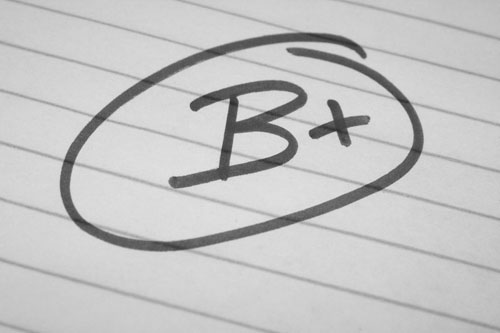Updated – August 30, 2020
An article in The Atlantic entitled “Letter Grades Deserve an F” by Jessica Lahey struck a cord and inspired this post. Ms. Lahey writes, “points-based grading undermines learning and creativity, rewards cheating, damages students’ peer relationships and trust in their teachers, encourages students to avoid challenging work, and teaches students to value grades over knowledge.” As I read the article I wished I could recapture the hours of anguish I suffered in school for all the “B”s I received. You see, I hated “B”s, more than “C”s or “D”s. Getting a “C” or “D” meant that I hadn’t understood the material, which was fair and acceptable, but a “B”? On an essay it meant the writing was good, but not really great, and on a test it was a reminder that I was okay but not perfect. A “B” was like a bullet fired at my self-esteem.
This problem persisted until the beginning of my junior year at UCLA when I realized that because I was striving for an “A”, maybe that’s why I wasn’t getting as many as I wanted. I decided to experiment and try something different. I told each of my instructors that they could write as many comments as they wanted on a paper of mine, but not to put a letter grade on it. If they put one in their grade books, fine, but don’t tell me what it was.
Suddenly I felt free. I wrote what I wanted to write. If I was inspired to write a paper in the style of a church sermon, I did. If I had to compare two films (I was a motion picture major), I could pick two unlikely films I liked and not care if the essay turned out well or not.
But a curious thing happened. My instructors would hand back my papers, shake their heads, and say they didn’t understand why I didn’t want a grade. Some even exclaimed that I had written the best paper in the class!
Fast forward a number of years later when I was I teaching a senior class at an art college. In design there is never a “right” answer, and I found myself spending an inordinate amount of time breaking students’ habits that came from years of schooling. I found them striving for that great idea or right answer, or even the elusive “A”. I broke them of this habit by making them generate a lot of ideas, not caring if they were good or bad, and if they found these ideas in the allotted time – a very short period – they got an “A.”
If you strive to find one great idea, you rarely find it. But if you generate a lot of ideas first, you might just discover one that is great. And that is what these students discovered.
A few years later, I was on a school board where our innovative district staff inserted a S.T.E.M. (Science, Technology, Engineering, Mathematics) class into the curriculum of the 6th grade classes. Brilliant. These S.T.E.M. classes taught that the “right answer” was not as important as the process – asking the right questions, experimenting, and being willing to try new ideas. This, I realized, was an answer to the letter grade dilemma.
We will never get rid of letter grades. They are engrained in our school system, and it’s what college admissions want to see. But we can teach our students that what’s important is to do their best, to experiment with ideas, and to work hard. Middle school is the best place to teach this. In middle school you can even fail a student and use that failure to teach him/her how to recover. Remember a “F” in middle school never shows up on high school transcripts sent to college.
But I’m not advocating that we fail students in middle school. On the contrary, we need to build their confidence. They need to learn how to recover from failure, to focus on innovation and hard work, not the grade. A middle school classroom and the online math and algebra lessons of ElevatedMath.com provide an opportunity to help students gain a mastery of the grading system, and not feel subservient to it. This can happen if the focus remains on understanding concepts and not just getting right answers.

